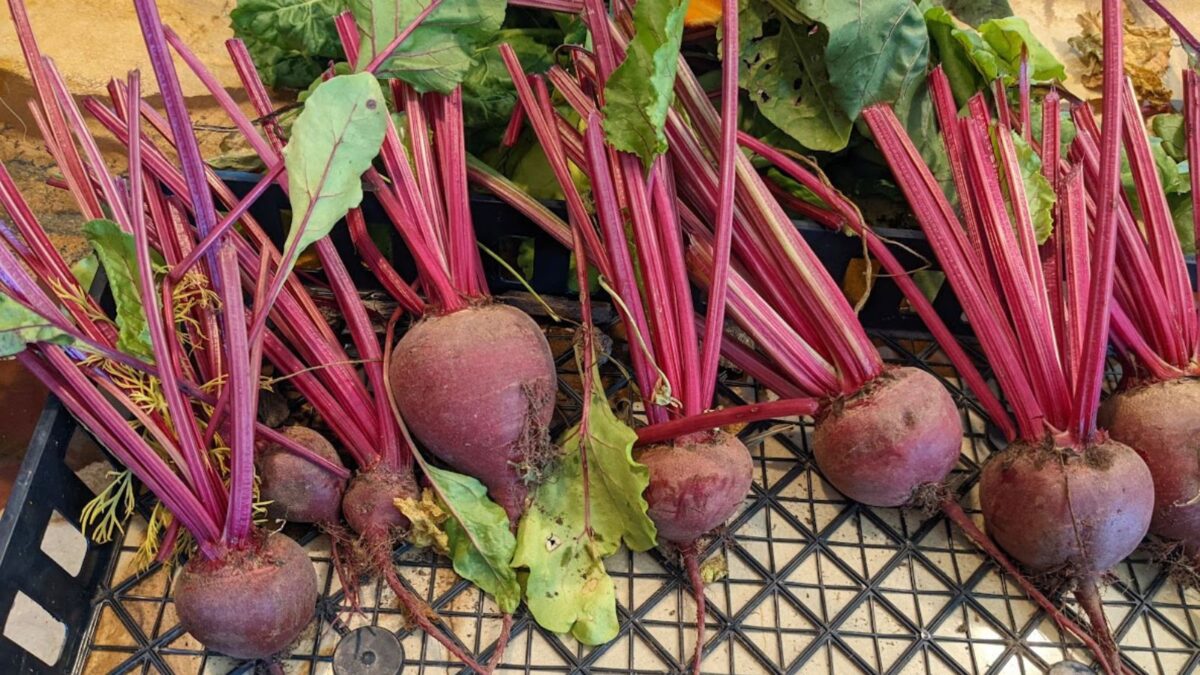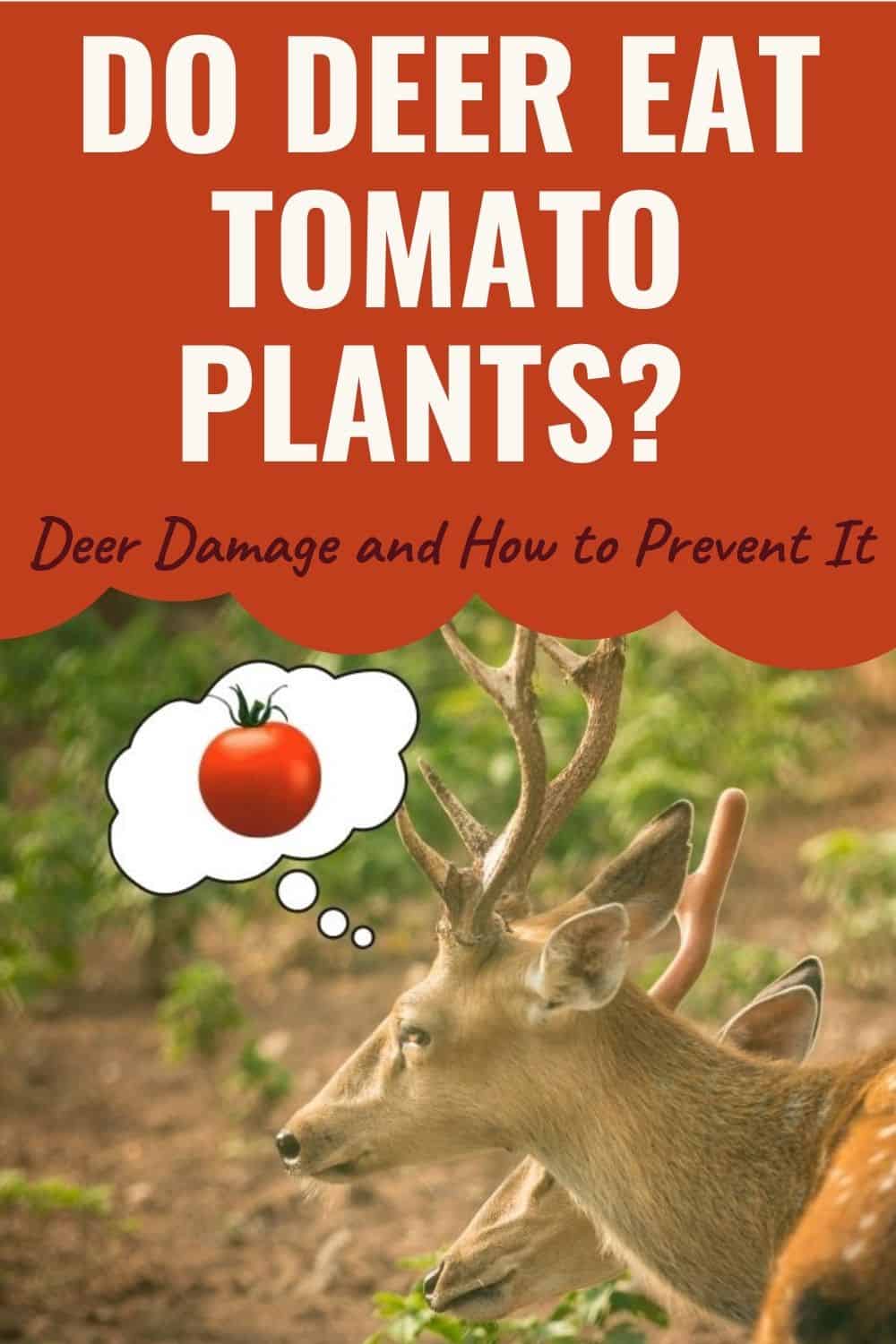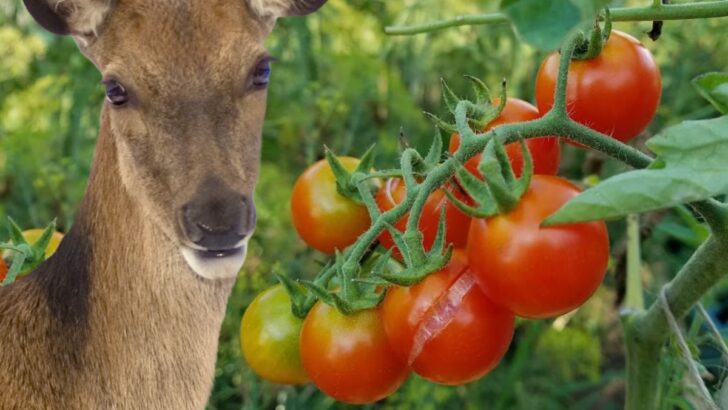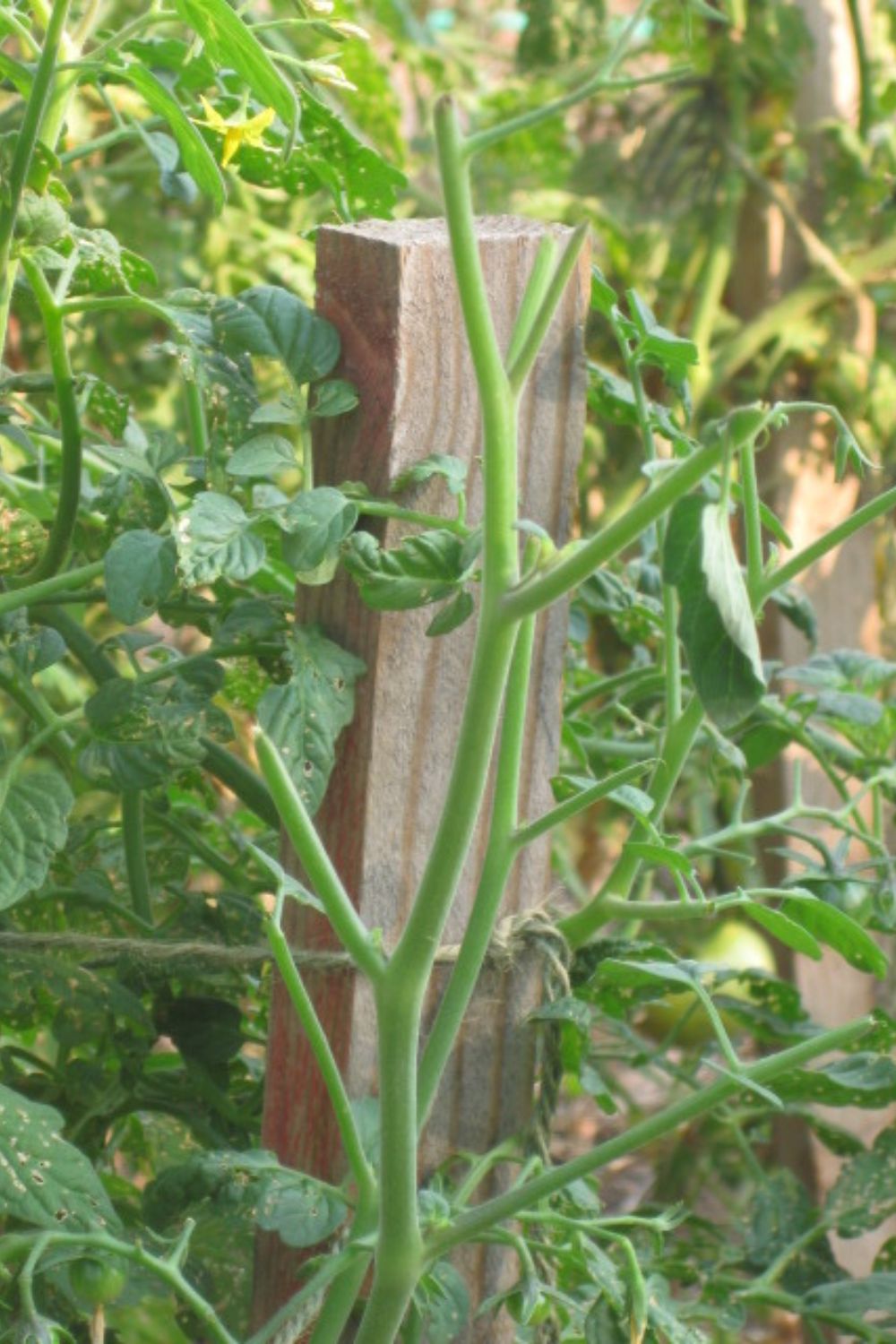It’s a bit eerie, not to mention disappointing, to walk out to the garden and find some – or all! – of your tomato plants missing without a trace. Once you’ve convinced yourself that you did, in fact, plant them, you might look closer and see tiny nubs where tomato vines used to be. So what happened? Do deer eat tomatoes and tomato plants, or did something else devour your hard work?

Do Deer Eat Tomatoes and Tomato Plants?
If something is eating your tomato plants, deer might be the culprits. They need to eat as much as seven pounds of vegetation a day, and they will happily much on all parts of the tomato plants. Before we move on to how to protect tomatoes from deer, let’s take a look at the damage and confirm that it was, in fact, caused by deer.
Identifying damage
To determine who has been snacking on your tomato plants, you must consider which part of the plant has been damaged and where on the plant the damage is located.
If ripe or almost-ripe tomatoes are being nibbled on towards the top of the plant, chipmunks or squirrels are likely the culprits. Similarly, birds sometimes peck telltale holes into the fruits.
Damage to lower-hanging tomatoes can be attributed to groundhogs or raccoons.
But what if foliage, not fruit, disappears? Tomato hornworms will defoliate a plant leaf by leaf, sometimes devouring entire plants over time. Due to excellent camouflage, they are often easiest to spot by first looking for their dark green droppings and then searching for the large green caterpillar perched nearby.
Neatly clipped (and eaten) stems and leaves near the ground point toward rabbits, while a severed stem was likely caused by a vole, especially if tunnels wind through your garden.
This brings us to deer.
Deer damage can resemble that of rabbits, but deer are typically less neat, will eat every part of the plant, and often devour more in one go. If entire plants disappear or large amounts of foliage have been torn off, you likely have deer visiting your garden at night. Look for hoof prints in soft, bare soil in and around your garden.
What other plants do deer eat?
Tomatoes aren’t the only plants in your garden in danger of browsing deer. Although a full list would be nearly endless, here are a few garden plants that deer especially enjoy eating.
Keep in mind that deer preferences vary from one location to another, especially regarding more regional plants, so check with your local extension office for more comprehensive lists of deer-preferred and deer-resistant plants in your specific area.
Vegetables:

- beets
- lettuce
- spinach
- brassicas (cabbage, broccoli, etc.)
- carrot tops
- sweet potatoes
- beans and peas
- sweetcorn
Fruits:

- blueberries
- strawberries
- apples
- cherries
- plums
Ornamentals:

- hostas
- daylilies
- roses
- azaleas
- Japanese yew
- pansies
- arborvitae
- Indian hawthorn
- tulips
How to keep deer away from tomatoes (and other plants)
So now that you’ve properly identified the damage in your garden, how do you stop a deer from eating tomato plants?
There are many options available, so we’ll explore several tactics for deer proof gardens and whether they actually work. Of course, it’s important to keep in mind that what keeps deer out of one garden may not as be effective for another, often depending on factors like the size and location of the garden, the amount of damage caused, and how long the deer have been visiting your garden.
Once deer create a habit of feeding in a certain location, they can become very persistent, so you will likely have the best results if you can detect and respond to damage quickly. You may also need to try several different methods for protecting your garden against deer to find the strategy – or combination of strategies – that works best for you.
1. Create a deer barrier
A good deer fence is typically the most effective way to keep deer out of a garden, but it might also be the most expensive. Woven wire or wire mesh fencing is durable enough for long-term use yet offers flexibility for erection on uneven terrain, while electric fencing can be used as either a temporary or more permanent solution. Because deer can easily jump over the average garden fence, a wire deer fence needs to be at least eight feet tall to protect all but the smallest gardens.
For a multipurpose fence that keeps groundhogs, rabbits, and rodents out as well, bury a three-foot-tall, half-inch, welded-wire fence six inches into the soil. Then string an additional three wires above the fence at 18-inch intervals. Since this type of fence is not a full eight feet tall, it will be most effective if the deer have plenty of other grazing options. In fact, if deer only cause occasional, light damage, a five- to seven-foot fence might be enough of a deterrent, especially when combined with other methods.
A wire fence causes an unpleasant shock when deer touch their noses to it, discouraging them from approaching in the future. Of course, especially persistent deer may simply crawl under or step through the electric fence, so the bottom wire should be about ten inches above the ground, with five or six additional wires strung ten to 12 inches apart. Electric fencing is often used in combination with repellent sprays.
Fishing line may offer a cheap, simple alternative in cases of light deer activity. String high-test, monofilament fishing line two feet from the perimeter of the garden and 30 to 36 inches above the ground. When deer approach in the dark, their legs bump against the unseen line, making them wary and unwilling to continue forward.
Large numbers of deer, particularly stubborn animals, or those that forage in daylight will likely figure out how to get past this barrier, but it may be worth a try if you only have a few deer that visit at night.
When only a few individual plants, especially trees or shrubs, are affected, tree guards, tubes, wire cylinders, or netting may be all you need.
2. Try deer repellents
Many types of deer repellents exist on the market, with some people swearing by them and others calling them bogus. So do any of them really work?
As with many things, it depends. Deer repellent sprays come in two different forms: area repellent and contact repellent. Area repellent produces an unpleasant or frightening odor, like that of predator urine, to keep deer away from the garden. In addition to sprays, this type is also available in the form of deer repellent granules.
Contact repellent is sprayed directly on the plants to give them a disagreeable taste, such as putrescent eggs, cloves, garlic, and/or capsaicin. When using sprays on vegetable plants, make sure to choose natural products labeled for use on edible crops.
For best results, apply repellents early and often (according to package directions). If deer haven’t yet made a habit of munching on the plants, they will likely be less stubborn about it. It’s also helpful to switch repellents occasionally so the deer don’t become accustomed to one and start ignoring it.
Ultrasonic deer repellent, solar deer repellent lights, and motion-activated sprinklers may also deter hungry deer but are likely most effective when used in combination with other methods. Keep neighbors in mind when considering deterrents that produce substantial noise or light.
When I had deer jump my short garden fence, I strung up foil takeout containers and old CDs above the fence. Although this “barrier” only reaches about five to six feet high, the flashing, shiny objects seem to have convinced the neighborhood deer family to stay out of my garden: they seem to prefer the neighbor’s meadow and the nearby corn fields.
Other DIY deer repellents that might be worth a try include:
- human or pet hair
- bone tar meal
- wind chimes
- or scented bar soap (many people suggest Irish Spring soap specifically)
3. Choose deer-resistant garden plants

One way to keep hungry deer from eating all of your plants is to fill your garden with plants that they don’t like! This may be a bit harder with vegetables since you choose varieties based on what you want to eat, but you can definitely try replacing tasty ornamentals with less appealing alternatives. Here are a few attractive plants that are toxic or otherwise unpleasant to deer:
- boxwood
- juniper
- arrowwood viburnum
- andromeda
- blue mist shrub
- American holly
- bayberry
- daphne
- bush cinquefoil
- monkshood
- marigold
If you would like to try planting some deer-resistant vegetables as well, choose alliums and heavily fragranced herbs:
- onions
- garlic
- scallions
- leeks
- shallots
- chives
- mints
- rosemary
- thyme
- sages
- oregano
- basil
- lavender
4. Adopt a deer-deterring dog
If you’ve been thinking about adopting a dog, here’s another good reason to go for it: deer don’t like dogs (especially big, loud ones).
For daytime browsers, let the dog out during the times you most often see deer in the garden. Nighttime deer are a bit trickier, as you need to keep the dog’s welfare in mind. They’re not just deer deterrents but affectionate animals that need proper care and attention.
If you leave your dog out at night, provide adequate shelter and a humane way to keep the dog on your property. An invisible fence works great while tying the dog should be avoided.
5. Plant for – and/or against – deer
When planning or revising a garden design in an area often visited by deer, remember to create a buffer, not a buffet. Intersperse deer-resistant plants with those that deer prefer and use tighter plant spacing. This will help hide the tastier plants and encourage the deer to graze somewhere else.
You can further this effect by creating three planting zones: the outer edge of your property, where deer are most likely to browse; the middle space between house and property edge; and the area closest to the house.
In the outermost zone, put only plants that deer like the least. Intermingle deer-resistant plants with occasionally damaged plants in the middle zone, and save deer favorites for beds nearest the house. As an added benefit, these diverse, closely-spaced plantings will look lush and healthy and attract native pollinators.
Make a deer plan
Now that you’ve identified the deer damage and explored deer deterrent options, it’s time to make a plan to save your precious tomatoes. If your garden has suffered significant damage and it makes sense to build a fence, go ahead and start taking measurements and considering materials.
But maybe you just have a few deer nibbling, or your budget won’t allow for expensive fencing. In that case, consider which of the methods above best fit your situation, and give one or two a try.
Remember that some strategies are most effective when used together. Who knows, maybe fishing line and hot pepper spray will be the magic remedy for your deer problem!
So… now you know that deer love to eat tomatoes (actually they love eating the entire tomato plant): which methods will you use to keep them away?





How To Save A Dying Tomato Plant
Wednesday 28th of June 2023
[…] how to keep deer from eating tomatoes […]
Robin Wynne-Lloyd
Wednesday 29th of March 2023
The only plants I have found that deer will not eat are Devil's Trumpets Angel's Trumpets Periwinkles Oleanders. All poisonous. Happy gardening!
How To Prune Tomato Plants - A Simple, Straightforward Guide
Friday 13th of January 2023
[…] time to grow and produce fruit before frost sets in. If you have the unfortunate experience of deer chomping off entire tomato plants, as I did one year, head over to your local greenhouse and take advantage of their late-season […]
Backyard Vegetable Garden Ideas
Monday 8th of February 2021
[…] Do Deer Eat Tomatoes and Tomato Plants? […]
Common Gardening Problems With Super Simple Solutions
Tuesday 10th of November 2020
[…] Related: do deer eat tomato plants? […]